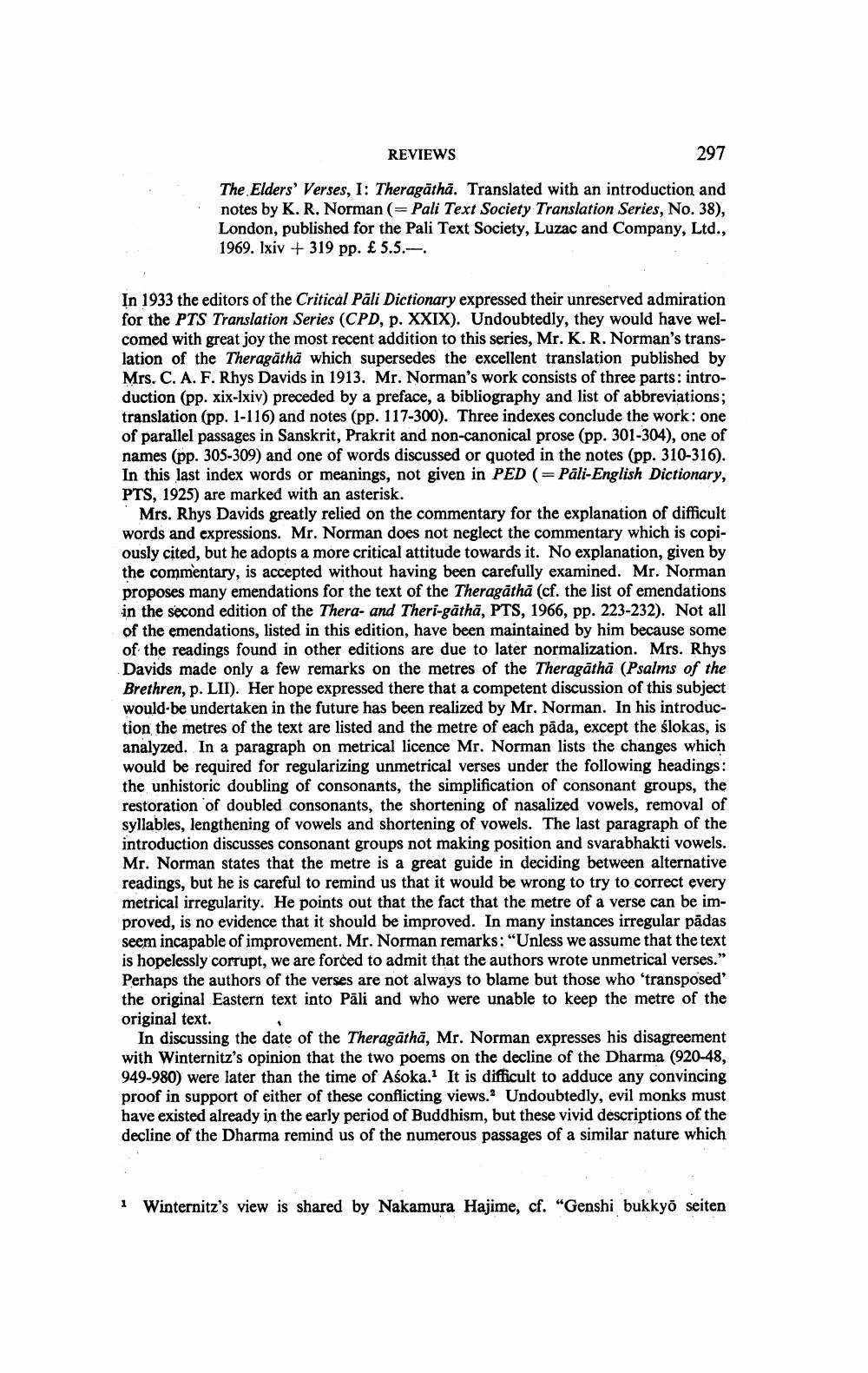Book Title: Reviews Of Different Books Author(s): Publisher: View full book textPage 1
________________ REVIEWS 297 The Elders' Verses, I: Theragatha. Translated with an introduction and notes by K. R. Norman (= Pali Text Society Translation Series, No. 38), London, published for the Pali Text Society, Luzac and Company, Ltd., 1969. Ixiv + 319 pp. PS 5.5.--. In 1933 the editors of the Critical Pali Dictionary expressed their unreserved admiration for the PTS Translation Series (CPD, p. XXIX). Undoubtedly, they would have welcomed with great joy the most recent addition to this series, Mr.K.R. Norman's translation of the Theragatha which supersedes the excellent translation published by Mrs. C. A. F. Rhys Davids in 1913. Mr. Norman's work consists of three parts: introduction (pp. xix-lxiv) preceded by a preface, a bibliography and list of abbreviations; translation (pp. 1-116) and notes (pp. 117-300). Three indexes conclude the work: one of parallel passages in Sanskrit, Prakrit and non-canonical prose (pp. 301-304), one of names (pp. 305-309) and one of words discussed or quoted in the notes (pp. 310-316). In this last index words or meanings, not given in PED (= Pali-English Dictionary, PTS, 1925) are marked with an asterisk. Mrs. Rhys Davids greatly relied on the commentary for the explanation of difficult words and expressions. Mr. Norman does not neglect the commentary which is copiously cited, but he adopts a more critical attitude towards it. No explanation, given by the commentary, is accepted without having been carefully examined. Mr. Norman proposes many emendations for the text of the Theragatha (cf. the list of emendations in the second edition of the Thera- and Theri-gatha, PTS, 1966, pp. 223-232). Not all of the emendations, listed in this edition, have been maintained by him because some of the readings found in other editions are due to later normalization. Mrs. Rhys Davids made only a few remarks on the metres of the Theragatha (Psalms of the Brethren, p. LII). Her hope expressed there that a competent discussion of this subject would-be undertaken in the future has been realized by Mr. Norman. In his introduction the metres of the text are listed and the metre of each pada, except the slokas, is analyzed. In a paragraph on metrical licence Mr. Norman lists the changes which would be required for regularizing unmetrical verses under the following headings: the unhistoric doubling of consonants, the simplification of consonant groups, the restoration of doubled consonants, the shortening of nasalized vowels, removal of syllables, lengthening of vowels and shortening of vowels. The last paragraph of the introduction discusses consonant groups not making position and svarabhakti vowels. Mr. Norman states that the metre is a great guide in deciding between alternative readings, but he is careful to remind us that it would be wrong to try to correct every metrical irregularity. He points out that the fact that the metre of a verse can be improved, is no evidence that it should be improved. In many instances irregular padas seem incapable of improvement. Mr. Norman remarks: "Unless we assume that the text is hopelessly corrupt, we are forced to admit that the authors wrote unmetrical verses." Perhaps the authors of the verses are not always to blame but those who 'transposed' the original Eastern text into Pali and who were unable to keep the metre of the original text. In discussing the date of the Theragatha, Mr. Norman expresses his disagreement with Winternitz's opinion that the two poems on the decline of the Dharma (920-48, 949-980) were later than the time of Asoka. It is difficult to adduce any convincing proof in support of either of these conflicting views.? Undoubtedly, evil monks must have existed already in the early period of Buddhism, but these vivid descriptions of the decline of the Dharma remind us of the numerous passages of a similar nature which 1 Winternitz's view is shared by Nakamura Hajime, cf. "Genshi bukkyo seitenPage Navigation
1 2 3 4 5 6 7 8 9 10 11 12 ... 23
